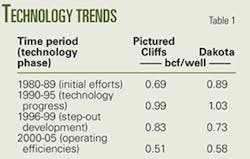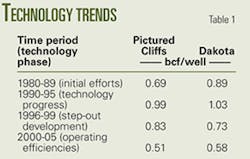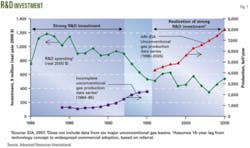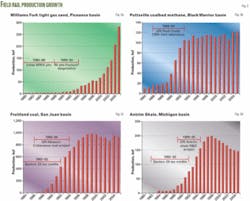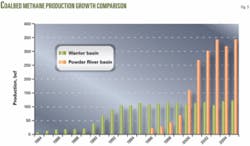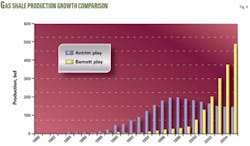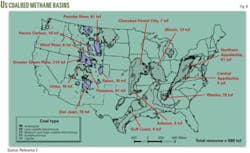UNCONVENTIONAL GAS-4: Technology, efficiencies keys to resource expansion
At the core of every successful unconventional gas play are two common themes: the continuous search for improvements in technology and the relentless pursuit of cost and operating efficiencies.
These two themes have transformed the previously overlooked uneconomic resources in tight gas sands, coalbed methane, and gas shales into today’s largest single source of domestic natural gas production.
The basic process, repeated over and over again, is that one or more new technology concepts lead to breakthroughs that transform the play from a technical curiosity to economic feasibility. Subsequent cost and operating efficiencies then permit aggressive commercial development and the extension of the play to less-favorable reservoir areas.
The evolution of per-well recoveries for unconventional gas plays attests to this cycle of initial technology breakthroughs followed by aggressive cost reductions.
At first, the per-well recoveries are relatively low. Then, they improve as a key technology concept is customized and applied to the particular reservoir properties of the gas play.
In the later, more mature stages of the play, per-well recoveries decline as companies pursue the less favorable reservoir portions of the play. Cost and operating efficiencies (gained during years of experience), however, allow the play to remain economic.
Table 1 presents an example of this technology and per-well performance cycle for two tight gas sand plays in the San Juan basin: the Pictured Cliffs, with 8.7 tcf of cumulative gas production, and the Dakota, with 6.7 tcf of cumulative gas production.
This fourth article in a six-part series on unconventional gas focuses on the importance of maintaining technology progress and further pursuing cost and operating efficiencies for unconventional gas development. The three previous parts in this series were in OGJ issues of Sept. 3, 2007, p. 35; Sept. 17, 2007, p. 64; and Sept. 24, 2007, p. 48,
Technology progress
Fig. 1 captures a number of key themes at the heart of technology progress in unconventional gas.
The first theme is the strong industry investment in oil and natural gas recovery research and development (R&D) that occurred during the 1980s and early 1990s. Fig 1 is based on data from 29 major US-based energy producing companies.1
Regarding these data, it is important to recognize that because a majority of these companies are multinational, most of this R&D investment was directed overseas to oil development and to deepwater technologies. Still, the trends in the data are instructive.
The recently issued NPC Global Oil and Gas Study puts the technology investment choices into clear perspective for large oil and gas companies:1 2 “R&D dollars, like capital expenditures, follow the most attractive opportunities, and these are increasingly found overseas.” As such, “the percentage [of the R&D dollar] focused on US-specific needs is relatively small.” Even smaller is the percentage of these R&D dollars directed to domestic unconventional gas, a resource that was, in the past, considered marginal by most of these major companies.
Second, an important portion of this post-R&D investment in unconventional gas was stimulated as cost share to key Gas Research Institute (GRI) and US Department of Energy (DOE) projects. These included GRI’s Rock Creek multiple coal seams field laboratory in the Warrior basin that established the scientific foundation for coalbed methane and the DOE-GRI sponsored multiwell experiment (MWX) in the Williams Fork formation of the Piceance basin that subsequently provided the foundation for today’s hydraulic fracture diagnostic technology and development of stacked tight gas sands.
These field-based R&D efforts were instrumental in building the knowledge base and technology for economically producing coalbed methane and tight gas sands. Large GRI and DOE R&D budgets in the 1980s and early 1990s helped define the technology needs and opportunities (concepts) in unconventional gas and brought down the risks of early technology application.
Third to note is the onset of increasing commercial-scale production of unconventional gas in the late 1990s. The timing of this delayed onset of increasing production reflects a second key technology finding in the recent NPC’s Global Oil and Gas Study,2 “Commercializing technology in the oil and gas market is costly and time-consuming; an average of 16 years passes from concept to widespread commercial adaption.”
Last is the onset of higher domestic natural gas prices, starting in year 2000, when Henry Hub spot prices consistently exceeded $4/Mcf. These higher prices along with earlier (1982-92) Section 29 tax credits, provided the capital and economic support for applying advanced unconventional gas technology at significant commercial scale.
Noteworthy examples of such technology breakthroughs include the concepts of stimulation through cavitation for the Fruitland coals in the San Juan basin fairway, application of slickwater-fracturing in the Fort Worth basin Barnett shale, and pursuit of low-resistivity tight gas sand pay in the Jonah and Pinedale fields in the Greater Green River basin.
Numerous examples demonstrate how field-based R&D efforts also can have an important impact on the pace of unconventional gas development. These examples include GRI’s Rock Creek multiple coal seams completion project in the Black Warrior basin, GRI’s Western Cretaceous coal seams project in the San Juan basin, GRI’s Antrim Shale R&D program in the Michigan basin, and GRI’s highly instrumental test well in the Barnett shale of the Fort Worth basin.
While these field-based R&D efforts helped build the base of science, they were most valuable in accelerating the commercial development of these four unconventional gas plays (Figs. 2a-2d).
A common noteworthy trait shared by each of these successful field R&D programs was the close partnership between an outside R&D team, a team with considerable independent financial resources and technical expertise, and one or more local operating companies to ensure that the R&D was focused on topics that had practical, value-adding impacts.
In our view, either party in isolation would not have achieved the same level of success in the same time frame. An R&D team, however well funded, could not produce the same results without the active involvement of field operators. By the same token, an operator (with limited R&D resources) likely would not have taken the risks of independently pursuing, rigorously evaluating, and then aggressively applying new, unproven technology concepts.
This brings us to an important, overall realization with respect to technology development partnerships-they help define and validate technology concepts and then help accelerate the pace of technology adaptation and application of these concepts to the basin-specific needs of each unconventional gas play.
Left to their own scientific interests and needs, operators would eventually define and validate the technologies required to unlock an unconventional play and then adapt this technology to their local reservoir settings. The issue is-with benefit of an R&D partner and pooling of industrial expertise, how much more quickly would this process evolve?
An empirical look at the growth in two pairs of plays, the Warrior and Powder River basin coalbed methane plays (Fig. 3), and the Antrim and Barnett gas shale plays (Fig. 4), helps answer this question.
In both cases, the former, less-prolific play received considerable field R&D attention and as a result achieved accelerated commercial-scale gas production. The latter plays, despite ultimately proving to possess superior productive and commercial qualities, took much longer to attain the same levels of gas production.
In the coalbed methane case, with the benefit of a strong GRI-sponsored field R&D program, the Warrior basin CBM production increased to 50+ bcf/year in 1991. In contrast, the more prolific Powder River basin play, even with the benefit of previously developed CBM science but without the benefit of a strong field-based R&D program, did not attain that production until 2000.
Similarly, the Antrim shale produced 50+ bcf/year in 1991, while the more prolific Barnett shale did not produce that much until 2000.
Thus based upon this anecdotal evidence, once a technology concept is shown to be valid, field-based R&D efforts can accelerate application of this technology to commercial levels by as much as a decade.
Pursuing efficiencies
The concept of cost operating efficiency gains in unconventional gas development is well established. Examples include the 24 hr/day, 7 days/week frac-factory concept being implemented by Shell Exploration & Production Co. and Ultra Petroleum Corp. in selected tight gas sand plays in the Rocky Mountains; Southwestern Energy Inc.’s assembly of a customized drilling fleet for horizontal wells in the Fayetteville shale; and, the assembly-line process being implemented for drilling and completing Powder River basin coalbed methane wells.
Cost and operating efficiency gains are perhaps best illustrated by improvements in drilling penetration rates for a play over time. Fig. 5 illustrates this trend for drilling wells to the Dakota sand at the Moxa Arch of the Greater Green River basin during the 1990s. While the public domain lacks data that would rigorously document similar trends of learning and cost reductions for other areas of unconventional gas technology, such as hydraulic fracturing, their existence and importance nevertheless exist.
In today’s economic environment of rapidly rising service and supply costs, it may not be possible to achieve absolute cost reductions via operating efficiencies. This does not mean, however, that companies are not realizing such gains. It means that costs are increasing faster than gains in efficiency.
This situation is unsustainable. At some point operational efficiencies need to again outpace increases in service and supply costs or a significant number of the unconventional gas plays will become prematurely uneconomic.
An important question is-who are the R&D entities that will develop the new concepts and help facilitate technology progress in unconventional gas in the timeframe required to meet rising demand for natural gas? DOE and GRI, the two organizations that funded prior publicly accessible R&D in unconventional gas, now lack funding. Private-sector funding for supply related oil and gas recovery has declined by two-thirds (in real dollars)1 from its peak in the early 1980s to 2003, although an increase is noted in the past 2 years (Fig. 1).
Many companies that once had large R&D programs have either disbanded them or the companies disappeared as a result of mergers and acquisitions. Many of these internal groups that remain have been retooled into technical service providers, primarily in support of large-scale international operations.3
Fortunately, the Energy Policy Act of 2005 establishes funding for unconventional gas R&D at $14 million/year for the next 10 years, out of an annual R&D allocation of $50 million. While a valuable first step, given the host of technical issues to be addressed and the increasing contribution being made by unconventional gas (now producing nearly 24 bcfd) a more robust R&D program would deliver higher value.
The organization selected to oversee and manage this R&D is the Research Partnership to Secure Energy for America (RPSEA), a nonprofit corporation formed by a consortium of US energy research universities, industry, and independent research organizations. In the area of unconventional gas, RPSEA’s goals are to:
- Increase the size of the technically recoverable unconventional gas resource base by 30 tcf.
- Convert 10 tcf of technically recoverable unconventional gas to economically recoverable gas.
- Pursue technologies for developing unconventional resources with minimum environmental impact.
- Emphasize science-building capacity and effective technology dissemination.
Technologies on horizon
As presented in the previous article, a significant marginally economic and uneconomic resource base exists for unconventional gas. The new and emerging unconventional gas plays that will require next-generation technology will likely include, among others:
- The deep poorly defined Upper Cretaceous (Mesaverde) tight gas sand plays in the Big Horn, Columbia, and Unita basins.
- The deep coals of the Greater Green River and Piceance basins, containing an estimated 400+ tcf of in-place resources; and the Tertiary coals of the Gulf Coast (Fig. 6).
- The Rocky Mountain gas shales along the Cretaceous-age seaway that stretches from the San Juan basin in the south to the Big Horn basin in the north, involving the Lewis, Mancos, Steele, and Cody shales.4
The technologies required to tap these currently undeveloped unconventional gas resources, in the authors’ view, based on discussions with unconventional gas developers includes:
- Sweet-spot detection technologies that identify in advance the location of highly productive, naturally fractured fairways where the small-scale fracture system is open.
- Reservoir characterization methods that reliably identify the entire productive pay interval.
- Advanced well stimulation alternatives economically applicable to the low end of reservoir quality.
- Enhanced-recovery technology that uses carbon dioxide or nitrogen injection to accelerate and increase gas recovery from coals, shales, and possibly tight sands.5
With a vast untapped unconventional gas resource base, a strong demand for natural gas, a resourceful industry willing to explore and develop new unconventional plays, and an R&D organization willing to assist in technology development, many of the prerequisites for a second era of successful unconventional gas technology development are in-place.
What is now required is an appropriate level of human and capital investment to both create new unconventional gas technology concepts and then help accelerate their adaptation and widespread commercial application.
References
- Energy Information Administration, Performance Profiles of Major Energy Producers 2005, DOE/EIA 0206(05), December 2006.
- National Petroleum Council, “Facing the Hard Truths about Energy,” July 18, 2007.
- Gratton, P.J.F., written testimony presented to the US Senate Subcommittee on Energy and Water Appropriations, Apr. 29, 2005.
- Brett, J.F., and Gregoli, M.K., “Successful Drilling Practices Study-Greater Green River Basin,” Final Report, prepared for Gas Research Institute, GRI-95/0132.1, March 1995.
- Reeves, S.R., “Assessment of CO2 Sequestration and ECBM Potential of U.S. Coalbeds,” Advanced Resources International, Inc., Topical Report, Oct. 1, 2002-Mar. 31, 2003, U.S. Department of Energy, DE-FC26-00NT40924, February 2003.
The authors
Scott R. Reeves is executive vice-president of Advanced Resources International Inc. He provides technical consulting and advisory services to clientele throughout the world and performs research on behalf of the US Department of Energy, the Gas Technology Institute, and others. Reeves holds a BS in petroleum engineering from Texas A&M University and an MBA from Duke University.
George J. Koperna Jr. is a project manager and reservoir engineer with Advanced Resources International Inc. He has more than 10 years of experience in reservoir modeling and CO2 injection for enhanced recovery and storage. Koperna holds a BS and an MS in petroleum and natural gas engineering from West Virginia University.
Vello A. Kuuskraa’s photo and biographical information appeared in Part 1 of this series (OGJ, Sept. 3, 2007, p. 35).
